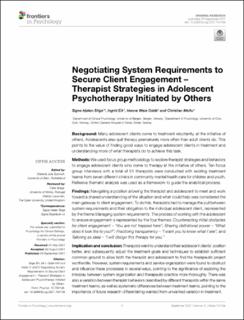| dc.contributor.author | Stige, Signe Hjelen | |
| dc.contributor.author | Eik, Ingrid | |
| dc.contributor.author | Oddli, Hanne Berit Weie | |
| dc.contributor.author | Moltu, Christian | |
| dc.date.accessioned | 2022-04-21T12:00:50Z | |
| dc.date.available | 2022-04-21T12:00:50Z | |
| dc.date.created | 2021-10-28T17:46:36Z | |
| dc.date.issued | 2021 | |
| dc.identifier.issn | 1664-1078 | |
| dc.identifier.uri | https://hdl.handle.net/11250/2992000 | |
| dc.description.abstract | Background: Many adolescent clients come to treatment reluctantly, at the initiative of others. Adolescents also quit therapy prematurely more often than adult clients do. This points to the value of finding good ways to engage adolescent clients in treatment and understanding more of what therapists do to achieve this task.
Methods: We used focus group methodology to explore therapist strategies and behaviors to engage adolescent clients who come to therapy at the initiative of others. Ten focus group interviews with a total of 51 therapists were conducted with existing treatment teams from seven different clinics in community mental health care for children and youth. Reflexive thematic analysis was used as a framework to guide the analytical process.
Findings: Navigating a position allowing the therapist and adolescent to meet and work toward a shared understanding of the situation and what could help was considered the main gateway to client engagement. To do this, therapists had to manage the pull between system requirements and their obligation to the individual adolescent client, represented by the theme Managing system requirements. The process of working with the adolescent to ensure engagement is represented by the four themes: Counteracting initial obstacles for client engagement – “You are not trapped here”; Sharing definitional power – “What does it look like to you?”; Practicing transparency – “I want you to know what I see”; and Tailoring as ideal – “I will design this therapy for you.”
Implication and conclusion: Therapists want to understand their adolescent clients’ position better, and subsequently adjust the treatment goals and techniques to establish sufficient common ground to allow both the therapist and adolescent to find the therapeutic project worthwhile. However, system requirements and service organization were found to obstruct and influence these processes in several ways, pointing to the significance of exploring the interplay between system organization and therapeutic practice more thoroughly. There was also a variation between therapist behaviors described by different therapists within the same treatment teams, as well as systematic differences between treatment teams, pointing to the importance of future research differentiating wanted from unwanted variation in treatment. | en_US |
| dc.language.iso | eng | en_US |
| dc.publisher | Frontiers | en_US |
| dc.rights | Navngivelse 4.0 Internasjonal | * |
| dc.rights.uri | http://creativecommons.org/licenses/by/4.0/deed.no | * |
| dc.title | Negotiating System Requirements to Secure Client Engagement – Therapist Strategies in Adolescent Psychotherapy Initiated by Others | en_US |
| dc.type | Journal article | en_US |
| dc.type | Peer reviewed | en_US |
| dc.description.version | publishedVersion | en_US |
| dc.rights.holder | Copyright 2021 The Author(s) | en_US |
| dc.source.articlenumber | 704136 | en_US |
| cristin.ispublished | true | |
| cristin.fulltext | original | |
| cristin.qualitycode | 1 | |
| dc.identifier.doi | 10.3389/fpsyg.2021.704136 | |
| dc.identifier.cristin | 1949422 | |
| dc.source.journal | Frontiers in Psychology | en_US |
| dc.identifier.citation | Frontiers in Psychology. 2021, 12, 704136. | en_US |
| dc.source.volume | 12 | en_US |

